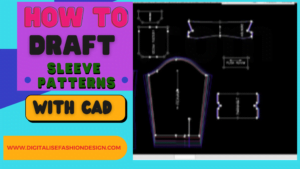0utline
- Introduction to CAD Dress Pattern Making
- What is CAD?
- Importance of CAD in Dress Pattern Making
- Understanding Dress Patterns
- What are dress patterns?
- Types of dress patterns
- Traditional vs. CAD Pattern Making
- Traditional pattern making techniques
- Advantages of CAD pattern making
- Getting Started with CAD Dress Pattern Making
- Software requirements
- Familiarizing yourself with the CAD interface
- Creating Basic Dress Patterns
- Taking body measurements
- Using CAD tools to draft a basic dress pattern
- Customizing Dress Patterns
- Modifying existing patterns
- Adding design elements and details
- Grading and Sizing
- Scaling patterns for different sizes
- Maintaining proportions and fit
- Testing and Refining Patterns
- Creating a muslin prototype
- Making adjustments based on fitting trials
- Exporting and Sharing Patterns
- Generating printable pattern files
- Collaborating with others in the fashion industry
- Challenges and Tips for Successful CAD Pattern Making
- Overcoming common obstacles
- Helpful techniques and resources
- Conclusion
- FAQs
Introduction to CAD Dress Pattern Making: A Beginner’s Guide
CAD dress pattern making is a revolutionary technique that has transformed the fashion industry, allowing designers to create intricate and accurate dress patterns with ease. If you’re new to CAD and interested in learning how to create dress patterns digitally, this beginner’s guide will provide you with a comprehensive introduction to the world of CAD dress pattern making.
What is CAD?
CAD stands for Computer-Aided Design, which involves using computer software to create, modify, and analyze designs. In the context of dress pattern making, CAD enables fashion designers to develop patterns digitally instead of relying solely on traditional manual methods. With CAD software, designers can draft, edit, and visualize dress patterns on a computer screen, resulting in increased efficiency and precision.
Importance of CAD in Dress Pattern Making
CAD has revolutionized the fashion industry by streamlining the pattern-making process and providing numerous advantages over traditional methods.
By adopting CAD for dress pattern making, designers can save valuable time, reduce material wastage, and achieve higher accuracy in pattern creation.
Additionally, CAD offers the flexibility to experiment with designs, make adjustments easily, and collaborate with others seamlessly.
Understanding Dress Patterns
Before diving into CAD dress pattern making, it’s essential to understand what dress patterns are and their significance in the fashion world. Dress patterns serve as templates that guide the cutting and assembly of fabric pieces to construct a garment.
They determine the shape, fit, and style of a dress, making them fundamental to the entire dressmaking process.
There are various types of dress patterns, including basic blocks, slopers, and style patterns.
Basic blocks are the foundation of dress patterns and represent the generic shapes of garments, such as bodices, skirts, and sleeves.
Slopers are more specific to individual body measurements and serve as a starting point for customization. Style patterns incorporate design elements, such as collars, pockets, or pleats, to create unique and tailored garments.
Traditional vs. CAD Pattern Making
Traditionally, dress patterns were created by hand using tools like rulers, pencils, and paper.

This process involved taking measurements, drafting patterns on paper, and manually adjusting them to achieve the desired fit. While traditional pattern making methods have their merits, they can be time-consuming, labor-intensive, and prone to human error.
CAD pattern making offers significant advantages over traditional methods.
With CAD software, designers can create accurate and symmetrical patterns with precise measurements in a fraction of the time. CAD tools allow for easy modification, duplication, and resizing of patterns, making it simpler to experiment with different design variations.
Moreover, CAD pattern files can be stored digitally and easily shared with colleagues or manufacturers, enhancing collaboration and reducing the risk of pattern loss or damage.
Getting Started with CAD Dress Pattern Making
To begin your CAD dress pattern making journey, you’ll need appropriate software and a basic understanding of the CAD interface. There are several CAD software options available, ranging from industry-standard programs like Adobe Illustrator and CorelDRAW to specialized fashion CAD software like Optitex and Gerber Accumark.
Once you have the software installed, familiarize yourself with the CAD interface. Learn about essential tools such as lines, curves, arcs, and shapes that will enable you to draft and modify patterns. Understanding how to input measurements accurately into the software is crucial for creating well-fitted dress patterns.
Creating Basic Dress Patterns

Creating a basic dress pattern using CAD involves a series of steps. Firstly, take accurate body measurements to ensure the pattern fits correctly. Then, utilize the CAD tools to draw the basic block corresponding to the desired garment piece, such as the bodice or skirt. Follow industry-standard guidelines to establish key points and lines, ensuring the pattern’s proportions and balance are correct.
Once the basic block is created, refine the pattern by adding seam allowances, darts, and notches. These elements are crucial for proper garment construction and assembly.
With CAD, you can easily adjust and fine-tune these details until you’re satisfied with the final pattern.
Customizing Dress Patterns
One of the significant advantages of CAD dress pattern making is the ability to customize patterns with ease. CAD software allows you to modify existing patterns by adding or removing design elements, adjusting lengths, widths, or shapes, and experimenting with various style variations.
RELEVANT BLOG POST
Whether you want to create a unique neckline, incorporate pleats or gathers, or experiment with different sleeve styles, CAD offers the flexibility to bring your design ideas to life. By simply manipulating the pattern on the screen, you can visualize and evaluate different design options before finalizing your choices.
Grading and Sizing
Grading refers to the process of scaling a pattern to different sizes while maintaining its proportions and fit.
CAD simplifies grading by automating the scaling process based on mathematical algorithms. With a few clicks, you can generate patterns for multiple sizes, ensuring consistency and accuracy.
Sizing is an essential consideration in dress pattern making, as different body shapes and proportions require adjustments to achieve the desired fit. CAD software allows you to customize patterns for specific body measurements, ensuring the garments flatter different body types. By inputting the required measurements, the software can generate customized patterns that cater to individual clients or market segments.
Testing and Refining Patterns
Once you’ve created your dress patterns digitally, it’s crucial to test them for fit and functionality. While CAD provides a visual representation of the pattern, it’s essential to validate its accuracy by creating a muslin prototype.
A muslin is a basic garment constructed from inexpensive fabric to assess the fit and make necessary adjustments. By analyzing how the muslin fits on a mannequin or a live model, you can identify areas that require modifications. Use CAD software to refine the pattern based on fitting trials, ensuring the final garment fits perfectly.
Exporting and Sharing Patterns
Once you’ve perfected your dress patterns in CAD, you can export them into printable pattern files. These files can be shared with manufacturers, sample makers, or other collaborators in the fashion industry. Export options may include formats like PDF, DXF, or AI, depending on the software you’re using.
RELEVANT YOUTUBE VIDEOS
Collaboration is a vital aspect of the fashion industry, and CAD facilitates seamless sharing and communication. Designers can work remotely with manufacturers, sending digital patterns instantly for production. This accelerates the garment creation process, reduces errors caused by misinterpretation, and fosters efficient collaboration across geographical boundaries.
Challenges and Tips for Successful CAD Pattern Making
While CAD dress pattern making offers numerous benefits, it’s important to be aware of potential challenges and implement effective strategies to overcome them. Some common challenges include:
- Learning Curve: Becoming proficient in CAD software requires time and practice. Invest in training resources, online tutorials, or courses to enhance your skills.
- Accuracy and Precision: CAD is highly precise, but it’s crucial to input accurate measurements and double-check pattern details to ensure the final garment fits correctly.
- Technical Issues: Software glitches or compatibility issues can occur. Regularly update your CAD software and maintain backup copies of your pattern files to minimize the risk of data loss.
- Pattern Manipulation: While CAD makes pattern manipulation easier, it’s important to preserve the integrity of the design and consider the fabric’s behavior during construction.
To overcome these challenges, focus on continuous learning, attention to detail, and collaboration with experienced professionals.
Join online communities or forums where you can seek advice, share knowledge, and stay updated with the latest CAD techniques and trends.
DOWNLOAD YOUR COSTOM BODY BLOCKS HERE
Conclusion
CAD dress pattern making is a game-changer for the fashion industry, offering designers a more efficient, precise, and flexible approach to creating dress patterns. By leveraging CAD software, designers can streamline their workflow, experiment with designs, and collaborate seamlessly. Whether you’re a beginner or an experienced designer, embracing CAD dress pattern making opens up endless possibilities for creativity and innovation.
FAQs
- Is CAD dress pattern making suitable for beginners? Absolutely! While there is a learning curve involved, many CAD software programs provide user-friendly interfaces and resources to help beginners get started.
- Do I need any specific hardware to use CAD for dress pattern making? You’ll need a computer or laptop capable of running the CAD software smoothly. Additionally, a digitizing tablet or a high-quality mouse can enhance your experience.
- Can I use CAD for pattern making in other areas of fashion, such as menswear or children’s clothing? Yes, CAD dress pattern making can be applied to various segments of the fashion industry. The techniques and principles remain the same; only the designs and measurements differ.
- Are CAD patterns more accurate than traditional hand-drafted patterns? CAD patterns offer a higher level of accuracy due to the precision of digital tools and automation. However, it’s important to ensure accurate measurements and meticulous attention to detail during the pattern creation process.
- Can CAD dress pattern making save costs in garment production? Yes, CAD dress pattern making can help reduce costs by minimizing material wastage, optimizing the use of fabric, and facilitating more efficient collaboration between designers and manufacturers.








